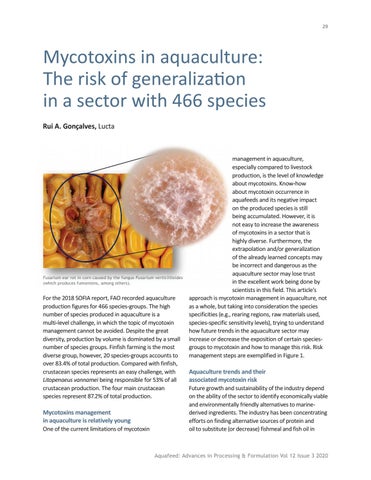29
Mycotoxins in aquaculture: The risk of generalization in a sector with 466 species Rui A. Gonçalves, Lucta
Fusarium ear rot in corn caused by the fungus Fusarium verticillioides (which produces fumonisins, among others).
For the 2018 SOFIA report, FAO recorded aquaculture production figures for 466 species-groups. The high number of species produced in aquaculture is a multi-level challenge, in which the topic of mycotoxin management cannot be avoided. Despite the great diversity, production by volume is dominated by a small number of species groups. Finfish farming is the most diverse group, however, 20 species-groups accounts to over 83.4% of total production. Compared with finfish, crustacean species represents an easy challenge, with Litopenaeus vannamei being responsible for 53% of all crustacean production. The four main crustacean species represent 87.2% of total production.
Mycotoxins management in aquaculture is relatively young One of the current limitations of mycotoxin
management in aquaculture, especially compared to livestock production, is the level of knowledge about mycotoxins. Know-how about mycotoxin occurrence in aquafeeds and its negative impact on the produced species is still being accumulated. However, it is not easy to increase the awareness of mycotoxins in a sector that is highly diverse. Furthermore, the extrapolation and/or generalization of the already learned concepts may be incorrect and dangerous as the aquaculture sector may lose trust in the excellent work being done by scientists in this field. This article’s approach is mycotoxin management in aquaculture, not as a whole, but taking into consideration the species specificities (e.g., rearing regions, raw materials used, species-specific sensitivity levels), trying to understand how future trends in the aquaculture sector may increase or decrease the exposition of certain speciesgroups to mycotoxin and how to manage this risk. Risk management steps are exemplified in Figure 1.
Aquaculture trends and their associated mycotoxin risk Future growth and sustainability of the industry depend on the ability of the sector to identify economically viable and environmentally friendly alternatives to marinederived ingredients. The industry has been concentrating efforts on finding alternative sources of protein and oil to substitute (or decrease) fishmeal and fish oil in
Aquafeed: Advances in Processing & Formulation Vol 12 Issue 3 2020




